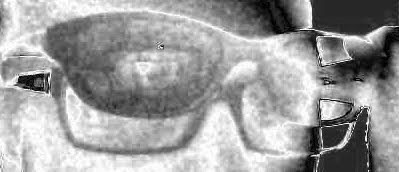I went to this exhibition with my daughter who has studied forensic science, and who has quite a different attitude to the material from my own more jumpy approach. She had heard of many of the names and objects in a way I had not, although some cases are well known outside of law. In fact, much of the development of the subject was driven by public interest and curiosity - a trait which continues to this day. Naturally people are interested in death and crimes which involve death - there's little that matters more when it comes to everyday occurrences. The exhibition caters for the viewer's prurient and salacious interests, but the bare facts of the dead body always makes the attention sober up.
Gallows humour is an important coping mechanism in confronting our fellow humans who leave behind evidence of suffering. We seem to need some sort of method of distracting ourselves from the relentless grim reality of what lies underneath. There's plenty to react to in this show - doll's house reconstructions of unsolved crimes from the 1940's, with murdered dolls and bloody scenarios.
Photographic evidence often betrays what the eye has an instinct for, that a dead body has something a bit wrong about it, even if death is not initially obvious - something wrong in the angles of the limbs or the head which a live person would never have, even in repose. Sometimes it's all too obvious that the body is a collection of remains, and we see our own constituent parts in ways we would never hope to.
Significant cases and development in the arts, science and technology of forensic investigation create images which have raw authenticity.
Facial reconstruction of Isabella Ruxton
University of Glasgow Archive Services, Department of Forensic Medicine and Science collection
This material doesn't need art to point anything out or signify its impact. Art could perhaps get it wrong - mediate the wrong message or interfere with the direct relationship the viewer has with the reality of death. We don't need art to point out the humanity of finger bones or shattered skulls, and so artists have a special sensitivity to display when working with human material. The Wellcome Trust has an established appreciation and relationship with the arts, not just in illustrative ways, but in researching and interpreting concepts and material.
Šejla Kamerić has made a a cold metal room installation that feels dangerous to enter as the door swinging to would make it the sort of chamber where only torture and death would occur. Video plays from a vast collection of footage, forensic evidence from the 1992 - 95 Bosnian War. Ab uno disce omnes (from one learn all) has a powerful presence in the gallery and the morgue fridge seems like a repository of threat just as much as a preservation of evidence. The random nature of the video projection means that each viewer has a unique showing, but also that the specific context of the piece is rather variable.
Šejla Kamerić
Ab uno disce omnes 2015
Could there be anything more horrendous, more moving and eloquent than disembodied human bones. Lined up, we recognise collar bones, hip bones, good god - finger bones, teeth. Jenny Holzer's table of human bones adds text through silver rings wrapped around some bones. Lustmord is a restrained piece, somehow bringing order to the chaos of sexual murder.
Jenny Holzer
Lustmord 312 bones, 33 with engraved silver rings, antique table, 1994
Forensics: The anatomy of crime
Wellcome Collection
Euston Road, London
26th February - 21st June 2015
@ExploreWellcome
28th February 2015




No comments:
Post a Comment